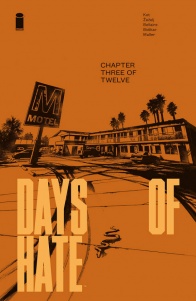A pair of fugitive guerilla fighters drives across the bleak American landscape while an ex-wife helps her interrogator catch his prey. Our review will contain minor spoilers.

Written by Ales Kot
Illustrated by Daniel Zezelj
Colored by Jordie Bellaire
Lettered by Aditya BidikarTake me home, country roads.
Good art reflects the nature of the times, and “Days of Hate” achieves this critical reflection, as ugly as it is. Ales Kot slices into the cultural zeitgeist of America, and finds the festering core of hatred within. “Days of Hate” may be the most relevant book on the overcrowded stands, one that earnestly attempts to tackle America’s division and what the future will hold if we continue to stew in its toxicity.
Chapter three is an issue where nothing substantive happens, save for the further characterizations of the series’ two main leads and their impending reunion. This chapter is entirely dialogue-driven. The history of Amanda, Huian and their unsalvageable relationship begins to unfurl. Equal time is spent on two conversations. One takes place between Amanda Parker and her partner in crime (has he still not been named?) while they travel across the country to Kansas for the next phase of their plan. Meanwhile, Peter Freeman continues the interrogation of Huian Xing for info regarding her ex-wife. Despite their distance, both literal and figurative, Amanda shares a story about Huian and vice versa. They share an anecdote revolving around a cup of tea, and the contradictions of each story shed light on these two damaged women. Huian inflicts her hatred upon herself while Amanda’s hatred has turned into misanthropy and murder.
‘The Ordinary Volk’ is entangled with the past. The issue begins with a line of dialogue: “I remember everything.” In the horror show of 2022 America, living in the past is the only remedy to deal with the present and ominous future. Word balloons are full of reminiscences, of pained voices longing for their former lives. The dialogue is occasionally didactic, but it always functions to build characters and fill in their complex histories. Given the subject matter of extrapolating America’s fractious political climate of 2018 into an even darker 2022, the script is artfully written. It mostly avoids facile political targets and instead focuses on the underlying causes of these issues: ignorance, self-hatred, and victimhood.
“The disappearance of a sense of responsibility is the most far-reaching consequence of submission to authority.” Kot opens with this quotation from Stanley Milgram on the title page, tying in to the greater themes of “Days of Hate.” Is this statement directed at the acquiescent Americans who allowed America to decay? Perhaps the most defining sequence of the issue is Amanda and her partner’s encounter of a white family hiking along the mountains. They are “the ordinary volk” of the title. They’re lost and ignorant of whom they’ve encountered. The encounter is deceptively mundane. Zezelj highlights the look in Amanda’s eyes before she lets out a harmless “Hello!” It’s terrifying. We’ve seen what Amanda is capable of, and one is left to wonder what could’ve happened had the traveling patriarch of the family said anything to offend her sensibilities. Amanda does her best to put on a mask of ordinariness, but she can’t quite disguise the malice behind her eyes.
Daniel Zezelj inks “Days of Hate” with a heavy brush, inflicting every line with suffocating darkness. Mountains, forests, and city skylines all appear charred in charcoal black. Only the faintest speckle of color breaks through, defeated under the encroaching vacuum of blackness. Without any context, the lone car driving through the wilderness may as well be a scene from post apocalyptic America. It’s as bleak as it gets. As far as the characters go, Zezelj employs a sort of geometric breakdown when drawing faces, reducing expressions to basic shapes for maximum impact.
When Jordie Bellaire is able to inject some color around Zezelj’s oppressive black ink, her color palette is appropriately subdued. The interrogation scenes are colored in neutral tones—all slate blue, grays and beige. A yellow-orange sunset provides a fitting backdrop to the tense encounter with the hikers. The sky’s hue deepens in intensity from saffron to cadmium orange, intensifying the suspense. Upon closer inspection, Bellaire’s colors have a sponge paint quality to them giving the illustrations a greater sense of dimensionality and enhancing Zezelj’s lines. Zezelj and Bellaire are truly in sync.
“Days of Hate” is realist post-apocalyptic fiction in a sense. Instead of zombies, the white supremacy has taken over an apathetic populace. ‘The Ordinary Volk’ doubles down on the gloom and doom of the first two issues, and the future doesn’t look any brighter. However, the hatred and horror of “Days of Hate” functions as an exigent call to readers. Dystopias can be avoided if we heed the call to change.
Final Verdict: 7.8 – The American nightmare grows ever darker as our fugitives hit the road and histories are unveiled in another bleak installment.



